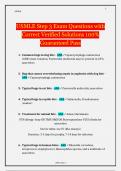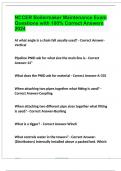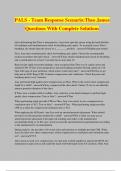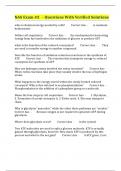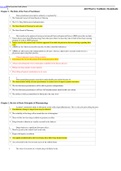1
USMLE
USMLE Step 3 Exam Questions with
Correct Verified Solutions 100%
Guaranteed Pass
1. Common bugs in dog bite - ANS ✓Capnocytophaga canimorsus
(GNR) most common, Pasteurella multocida may be present in 25%,
anaerobes
2. Bug that causes overwhelming sepsis in asplenics with dog bite -
ANS ✓Capnocytophaga canimorsus
3. Typical bugs in cat bite - ANS ✓Pasteurella multocida, anaerobes
4. Typical bugs in reptile bite - ANS ✓Salmonella, Pseudomonas
(snakes)
5. Treatment for animal bite - ANS ✓Amox/clavulanate
PCN allergy: doxy OR TMP/SMX OR fluoroquinolone PLUS clinda for
anaerobes
Severe infxn: use IV (like unasyn)
Duration: 3-5 days for prophy, 7-14 days for infection
6. Typical bugs in human bites - ANS ✓Eikenella corrodens,
streptococci, staphylococci, Haemophilus species, and a multitude of
anaerobes
USMLE Step 3
, 2
USMLE
7. Treatment for human bite - ANS ✓Same as animal bite but be
careful tendons or bones not involved if clenched fist
8. Common bugs in diabetic foot ulcer - ANS ✓staphylococci,
streptococci, enteric gram-negative rods, P. aeruginosa, and
anaerobes
9. Treatment of diabetic foot ulcer - ANS ✓Broad until cx results
known (if severe infection): must cover GPC, GNR, and anaerobes, e.g.
vanc + mero
If mild, cover for staph and strep
10. Aeromonas hydrophila - ANS ✓This gram-negative
bacterium is found in freshwater environments, although it may also
be present in brackish water. Infections are more likely to occur
during warmer weather. Soft tissue involvement and
bacteremia/sepsis can develop in patients with underlying
immunocompromising diseases, including cirrhosis and cancer. The
clinical presentations of infection with Vibrio vulnificus and
Aeromonas species can be quite similar. This organism is often
susceptible to fluoroquinolones, trimethoprim-sulfamethoxazole,
tetracyclines, imipenem, aminoglycosides, and third- or fourth-
generation cephalosporins
11. Treatment for necrotizing fasciitis - ANS ✓-need to cover
MRSA, GABHS, GNRs, anaerobes
-vanc AND: pip/tazo OR cefepime + metronidazole OR meropenem PLUS
clinda
-MUST add clinda if GABHS is suspected b/c it helps stop toxin production
and it is effective even when bacteria are in stationary phase
USMLE Step 3
, 3
USMLE
-ALSO need surgical tissue samples for culture in order to narrow abx
coverage
12. Treatment of toxic shock syndrome - ANS ✓-B lactam abx
(PCNs, cephs, carbapenems)
-AND clinda (important b/c b-lactams alone can cause INCREASED toxin
production)
-IVIG effective in strep TSS (in 1 study) but not proven in staph TSS
13. Rocky Mountain Spotted Fever - ANS ✓-caused by Rickettsia
rickettsii
-rash, fever, headache, GI sx, myalgia
-rash is initially erythematous maculopapular and progresses to petechial,
begins on wrists, ankles, palms and soles before spreading centripetally
14. Vibrio vulnificus - ANS ✓-GNR
-causes nec fas and sepsis, particularly in liver disease or
immunosuppressed pts
-hemorrhagic bullae
-exposure to warm sea or brackish water (Gulf of Mexico), seafood
drippings, consumption of raw seafood like oysters
15. CAP labs - ANS ✓-blood cx
-sputum cx
-influenza A&B rapid antigen test
-Legionella and strep pneumo urine antigen test
16. CURB65 - ANS ✓Confusion, Uremia, RR, low BP, age>65
USMLE Step 3
, 4
USMLE
-0-1: outpt
-2: inpt
-3+: ICU
17. CAP treatment - ANS ✓-outpt. previously health and no abx
use in last 3 mos: macrolide or doxy
-outpt. with comorbidites or hospitalized non-ICU: respiratory
fluoroquinolone OR b lactam + macrolide
-ICU: b lactam AND: resp. FQ or azithro
-treat for at least 5 days AND until pt. afebrile for 48-72 hrs and no more
than one abnormal vital sign
18. Risk factors for B lactam strep pneumo - ANS ✓-age less
than 2
-age greater than 65
-B lactam in prior 3 mos
-EtOHism
-comorbidities
-immunosuppressed
-exposure to child in daycare
19. Risk factors for community-aquired MRSA - ANS ✓-ESRD
-injection drug use
-prior influenza
-prior abx
USMLE Step 3

